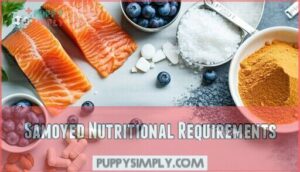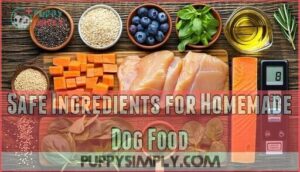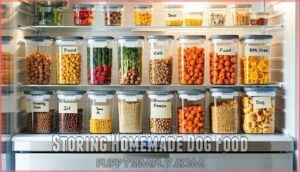This site is supported by our readers. We may earn a commission, at no cost to you, if you purchase through links.

Many Samoyed owners turn to homemade dog food, hoping to replicate the quality their ancestors enjoyed, but the gap between intention and execution can be dangerous. A single miscalculated recipe might rob your dog of essential calcium for those sturdy bones, or worse, introduce toxic ingredients that seem harmless to us.
The right homemade diet can transform your Samoyed’s health, energy, and coat quality, but only if you understand the precise nutritional requirements, safe ingredient combinations, and preparation methods that keep your dog thriving rather than just surviving.
Table Of Contents
- Key Takeaways
- Benefits of Homemade Samoyed Food
- Risks of Homemade Samoyed Food
- Samoyed Nutritional Requirements
- Puppies Vs Adults Homemade Food
- Best Homemade Recipes for Samoyeds
- Homemade Food Delivery Services
- Safe Ingredients for Homemade Dog Food
- Unsafe Ingredients for Homemade Dog Food
- Cooking Tips for Homemade Dog Food
- Storing Homemade Dog Food
- Frequently Asked Questions (FAQs)
- Can I mix kibble with homemade food for my Samoyed?
- What should I do if my Samoyed refuses to eat the homemade food I prepare?
- Is it safe to give homemade food to my senior Samoyed?
- How do I transition my Samoyed to homemade food?
- Can homemade food help with shedding issues?
- How often should I feed my Samoyed homemade meals?
- What equipment do I need for making dog food?
- Should I rotate proteins in my Samoyeds homemade diet?
- Conclusion
Key Takeaways
- Homemade diets give you complete control over your Samoyed’s nutrition, but improper recipes can cause dangerous nutrient deficiencies, bacterial contamination, or accidental poisoning from toxic ingredients like grapes, chocolate, onions, and xylitol.
- Adult Samoyeds need 1,100-1,500 calories daily with 18-25% protein and 12-18% fat, while puppies require 22-32 calories per pound with higher protein (22-25%) and more frequent meals to support rapid growth.
- Safe homemade meals should include thoroughly cooked proteins (chicken, beef, salmon), healthy carbs (brown rice, sweet potatoes), and proper calcium-to-phosphorus ratios (1:1 to 2:1), but you must consult a vet or canine nutritionist before switching diets.
- Store homemade food in airtight containers for 3-5 days refrigerated or 2-3 months frozen, and always transition your Samoyed gradually over 7-10 days to prevent digestive upset.
Benefits of Homemade Samoyed Food
Making your own dog food for your Samoyed puts you in the driver’s seat regarding what goes into their bowl. You’ll have complete control over ingredients, portions, and nutritional balance while potentially saving money compared to premium commercial options.
Here are three major advantages of preparing homemade meals for your fluffy companion.
Balanced Nutrition Control
When you make your Samoyed’s meals at home, you’re not just feeding them—you’re taking the reins on every nutrient that fuels their energy, bolsters their thick double coat, and keeps their body running like a well-oiled machine. You’ll master recipe formulation to meet Samoyed nutritional requirements, control nutrient proportions for a balanced diet, and refine calorie intake for your dog’s size and activity level.
This means you can:
- Adjust essential nutrients based on life stage
- Monitor portion control for weight management
- Integrate supplements when needed
- Fine-tune diet refinement through calorie counting
That’s real control over your dog’s health.
Affordable Fresh Ingredients
You don’t need to drain your wallet on pricey commercial kibble to keep your Samoyed healthy and thriving.
Homemade food lets you source budget proteins like chicken thighs or ground turkey in bulk, grab seasonal produce from farmer’s markets, and explore local sourcing options that slash costs.
Fresh ingredients from garden options or safe recipes you craft at home give you control without breaking the bank, especially when you plan meals around what’s affordable and available.
Tailored Dietary Requirements
Every Samoyed is different, and homemade meals give you the power to fine-tune their diet like a custom-fitted collar—perfectly adjusted to their age, allergies, and health quirks. You can address specific ailments like hip dysplasia with omega-rich recipes or manage weight with portion-controlled meals.
Life stage matters too—puppies need different essential nutrients than seniors, and activity level determines calorie density. If your Samoyed has food allergies or health conditions affecting their coat or digestion, you’ll control every ingredient to meet those dietary needs.
This flexibility lets you respond to your dog’s Samoyed nutritional needs as they evolve, whether you’re supporting cardiac health or accommodating breed size requirements.
Risks of Homemade Samoyed Food
Homemade diets aren’t a one-size-fits-all solution, and feeding your Samoyed improperly balanced meals can lead to serious health problems down the road. Nutrient imbalance is one of the biggest risks of homemade food—skipping essential vitamins or minerals can weaken your dog’s immune system, bones, and overall vitality. Improper recipes found online often lack the precision needed for complete nutrition.
Bacterial contamination from raw meat poses another danger, potentially causing digestive issues like vomiting or diarrhea. You’ll also need to avoid toxic ingredients such as onions, garlic, grapes, and chocolate, which are unsafe and can poison your dog. Even well-meaning owners can accidentally include toxic foods without realizing it.
That’s why consulting your veterinarian or a canine nutritionist is critical before switching diets, especially if your Samoyed has existing health conditions.
Samoyed Nutritional Requirements
Proper nutrition forms the foundation of your Samoyed’s health and longevity. You’ll need to provide a diet with 22-25% protein from quality protein sources like chicken, beef, fish, or lamb to maintain healthy muscles and immune function. Fat intake should range from 12-18% of total calories, with omega-3 fatty acids from fish oil supporting that gorgeous thick coat and reducing inflammation.
Caloric intake varies considerably—adult Samoyeds usually need 1,100 to 1,500 kilocalories daily, while highly active dogs may require up to 1,800. Puppies demand about 50-55 kilocalories per pound during growth, and seniors need 15-20% fewer calories to prevent weight gain. A protein-rich diet is essential for muscle development and overall health.
Don’t overlook vitamin needs: calcium and phosphorus maintain strong bones, while vitamins E, A, and C support immune health. Hydration levels matter too—your Samoyed needs at least one ounce of water per pound of body weight daily for best kidney function and energy.
Puppies Vs Adults Homemade Food
When your Samoyed transitions from puppyhood to adulthood, you’ll notice their homemade food needs shift dramatically to match their changing bodies. It’s important to remember that breed size matters when determining the right time to switch to adult food.
Puppies require about 22–32 calories per pound daily with 22–25% protein to fuel rapid growth, while adults need just 18–25 calories per pound with 18–21% protein to maintain health without weight gain. You’ll also adjust feeding frequency—puppies thrive on three to four meals daily until six months old, then taper to twice daily as adults.
| Life Stage | Caloric Needs | Protein Intake | Feeding Frequency |
|---|---|---|---|
| Puppies | 22–32 cal/lb | 22–25% minimum | 3–4 meals daily |
| Adults | 18–25 cal/lb | 18–21% minimum | 2 meals daily |
Growth rates demand careful attention—puppies gain 2–3 pounds weekly during their first six months, so you can’t simply feed adult portions. Supplement needs differ too: puppies benefit from DHA for brain development, while adults need glucosamine for joint support as they age.
Best Homemade Recipes for Samoyeds
Making homemade food for your Samoyed doesn’t have to be complicated. The right recipes combine balanced nutrition with ingredients your dog will actually enjoy.
Here are two tried-and-true options that meet your Samoyed’s dietary needs.
Bone Broth
Think of bone broth as liquid gold for your Samoyed’s health, packed with minerals that work from the inside out to strengthen bones, soothe joints, and support everything from immunity to digestion. Making broth is straightforward—simmer beef marrow bones or chicken feet with a splash of apple cider vinegar for 12-24 hours to extract calcium, phosphorus, and collagen. You can enhance the recipe by adding parsley or turmeric for their anti-inflammatory benefits.
Bone broth serves as liquid gold for Samoyeds, delivering minerals that strengthen bones, soothe joints, and support immunity through a simple 12-24 hour simmer
Broth safety means skipping onions and using fresh ingredients, while storage is simple: refrigerate for up to five days or freeze in portions for convenient meals.
- Supports joint health in active Samoyeds who love to run and play
- Aids digestion when your dog’s stomach feels off
- Boosts immunity during seasonal changes or stressful times
- Improves homemade dog food by adding moisture and flavor your Samoyed will crave
Chicken & Pumpkin
A chicken and pumpkin combo isn’t just comfort food for you—it’s a powerhouse meal for your Samoyed. This recipe delivers lean protein for strong muscles and fiber-rich pumpkin to keep digestion running smoothly.
Cook boneless chicken thoroughly, mix with plain canned pumpkin (not pie filling), and add brown rice for energy.
This recipe works year-round, though pumpkin benefits shine during seasonal transitions when your dog’s stomach needs extra support.
Homemade Food Delivery Services
If you’re short on time but still want to feed your Samoyed fresh, balanced meals, delivery services designed for homemade dog food might be exactly what you need. These services send pre-portioned ingredients straight to your door, along with vet-approved recipes that take the guesswork out of meal prep.
Here’s what makes homemade food delivery services worth considering:
- Recipe Customization adapted to your Samoyed’s age, weight, and health conditions
- Ingredient Sourcing from quality suppliers, ensuring freshness and safety
- Service Cost that’s generally higher than grocery store shopping but lower than premium commercial options
- Delivery Radius varies by company, so check availability in your area
- Freshness Guarantee with proper packaging to maintain ingredient quality during transit
These dog food delivery services won’t replace the hands-on control of sourcing your own ingredients, but they do make homemade food more accessible when life gets busy.
Safe Ingredients for Homemade Dog Food
When you’re building homemade meals for your Samoyed, knowing which ingredients belong in the bowl—and which don’t—is half the battle. Safe protein sources like chicken, turkey, beef, lamb, and salmon should be thoroughly cooked to eliminate pathogens. Organ meats such as liver can be included sparingly, at 5-10% of the diet, for iron and zinc without risking toxicity.
Healthy carbohydrates from brown rice, oats, quinoa, and sweet potatoes deliver steady energy and fiber, especially when they’re well-cooked for easy digestion. Essential fatty acids come from fish oil, flaxseed oil, and naturally fatty proteins like duck, supporting your dog’s skin and coat when balanced at 10-15% of total calories.
Don’t forget mineral balance—calcium and phosphorus ratios between 1:1 and 2:1 prevent skeletal issues, while a vet-approved premix ensures you’re hitting all the micronutrient targets.
| Ingredient Category | Safe Examples |
|---|---|
| Safe Protein Sources | Chicken, turkey, salmon, duck, rabbit |
| Healthy Carbohydrates | Brown rice, oats, quinoa, sweet potatoes |
| Vegetables & Fruits | Carrots, spinach, blueberries, pumpkin |
| Essential Fatty Acids | Fish oil, flaxseed oil, olive oil |
Unsafe Ingredients for Homemade Dog Food
While you now know what belongs in your Samoyed’s bowl, it’s just as important to recognize what doesn’t. Toxic foods for dogs include grapes and raisins, which trigger acute kidney failure at intakes as low as 0.7 ounces per kilogram of body weight. Chocolate causes theobromine toxicity—dark varieties can be fatal at just 20 mg/kg. Dangerous sweeteners like xylitol induce hypoglycemia and liver failure at doses as low as 50 mg/kg, and it’s often hiding in sugar-free baked goods.
Onions and garlic damage red blood cells when fed at 15–30 grams per kilogram, leading to hemolytic anemia. Raw meats and bones carry Salmonella, Listeria, and E. coli O157:H7—pathogens detected in recalled homemade-style pet foods in 2024 and 2025. Harmful carbohydrates such as raw potatoes contain solanine, causing nervous system disturbances, while corn syrup spikes blood sugar and contributes to obesity.
Toxic additives like BHA, BHT, and ethoxyquin are linked to organ toxicity and allergic reactions. Hidden contaminants—mold, mycotoxins, pesticides, and antifreeze—accounted for multiple poisoning cases.
Unsafe ingredients for homemade dog food also include:
- Avocado (persin toxicity)
- Macadamia nuts
- Alcohol
- Bread dough with yeast (gastric rupture, alcohol toxicity)
- Rendered fats (bacterial contamination)
- Meat and bone meal (diseased animal residues)
- Propylene glycol (hemolytic anemia)
- Artificial food dyes (Red 40, Blue 2)
- MSG and flavor enhancers
- Sodium and calcium caseinate
- Generic animal by-products
- Protein isolates
- Corn syrup
- Expired baked goods
- White rice and wheat flour (allergen triggers)
- Xylitol-containing products
- Chocolate-containing baked goods
- Rodenticides
- Antifreeze
- Pesticides
- Aflatoxin-contaminated grains
- Solanine-rich starches
Dog food and allergies are closely connected—many of these substances worsen allergies and skin conditions in sensitive Samoyeds. When in doubt, consult your vet before adding any new ingredient to your dog’s diet.
Cooking Tips for Homemade Dog Food
Once you’ve stocked your kitchen with safe ingredients and ruled out the toxic ones, you’re ready to master the cooking methods that preserve nutrients and keep meals safe for your Samoyed. Batch cooking lets you prepare several days’ worth of homemade dog food at once, saving time while ensuring consistency. Steam or bake lean proteins at 165°F to eliminate pathogens without destroying heat-sensitive B vitamins. Food processors simplify ingredient sourcing and homemade food preparation by blending fibrous vegetables your dog can actually digest.
Here are key cooking tips for homemade dog food:
- Cook proteins thoroughly but avoid overcooking, which denatures amino acids
- Use portioning tools to measure exact servings and prevent overfeeding
- Make recipe adjustments based on your Samoyed’s age, weight, and activity level
Skip seasoning—dogs don’t need salt or spices. Let cooked meals cool completely before portioning to avoid bacterial growth during the cooling process.
Storing Homemade Dog Food
After you’ve cooked your Samoyed’s meals with care, storing them correctly protects all that nutritional value and keeps your dog safe from foodborne illness. Refrigerate homemade food preparation within two hours to slow bacterial growth. Use shallow, airtight container types—glass or BPA-free plastic work best—and let meals cool completely before sealing to prevent condensation. Label each container with the date and contents.
Fridge storage keeps meals fresh for 3-5 days, while freezing portions extends shelf life to 2-3 months. Flatten freezer bags to remove air pockets before storing. When reheating, thaw slowly in the refrigerator overnight and warm gently.
Always inspect for spoilage signs before serving—off odors, slimy texture, or discoloration mean it’s time to discard the batch. Following these cooking tips for homemade dog food ensures your Samoyed gets safe ingredients every time.
Frequently Asked Questions (FAQs)
Can I mix kibble with homemade food for my Samoyed?
You’d think combining the best of both worlds would be simple, but kibble and homemade dog food digest at different rates, which can upset your Samoyed’s stomach.
You can mix them, but start slow—introduce kibble gradually to avoid digestive issues. Watch for changes in stool quality or energy levels, and adjust portion size accuracy to prevent overfeeding since kibble nutrient overlap may mean you’re doubling up on certain nutrients.
What should I do if my Samoyed refuses to eat the homemade food I prepare?
If your Samoyed won’t eat, first check that the food is fresh and properly cooled. Try warming it slightly to improve palatability, or mix in plain yogurt or no-salt broth as palatability improvers.
Gradual introduction helps, but persistent refusal warrants veterinary advice to rule out food sensitivities, allergies, digestive upset, or underlying issues requiring an elimination diet.
Is it safe to give homemade food to my senior Samoyed?
Just like silver on a muzzle tells a story, your senior Samoyed’s changing needs deserve attention.
Homemade food is safe if you adjust recipes for senior dogs’ nutritional needs—lower calories, joint-supporting supplements, softer textures for dental considerations, and enhanced palatability to maintain appetite as they age.
How do I transition my Samoyed to homemade food?
Introduce homemade meals gradually over 7-10 days, mixing small amounts with their current food. Monitor your Samoyed’s reactions closely, adjusting portions as needed.
Schedule a veterinary checkup to confirm they’re meeting nutritional requirements.
Can homemade food help with shedding issues?
You can’t stop a Samoyed from shedding—but you can dramatically reduce it with the right nutrients. Homemade food rich in Omega-3 promotes Coat Health Nutrients, while proper Hydration Impact and addressing Allergy-Related Shedding through specific Recipes improve Dog nutrition and overall coat health greatly.
How often should I feed my Samoyed homemade meals?
Most adult Samoyeds thrive on two meals per day, spaced roughly twelve hours apart. Feeding frequency depends on your dog’s activity levels, individual needs, and nutritional requirements.
Portion control and appropriate portion sizes prevent overfeeding while maintaining energy.
What equipment do I need for making dog food?
You’ll need basic kitchen gear: a food processor or grinder for meat, sturdy cooking utensils, accurate measuring tools, and airtight storage containers.
These essentials simplify meal preparation and keep homemade food fresh between feedings.
Should I rotate proteins in my Samoyeds homemade diet?
Yes, rotating proteins in your Samoyed’s homemade diet offers rotation benefits like allergy prevention and improved digestive health. Protein variety ensures nutritional completeness by providing different nutrient variations in diet, reducing the risk of developing food allergies or needing an elimination diet later.
Conclusion
A single nutritional miscalculation could quietly sabotage years of your Samoyed’s health—but with the right knowledge, you’re now equipped to feed them like the Arctic champions they were born to be.
Homemade dog food for Samoyed isn’t just about following recipes; it’s about understanding protein ratios, calcium balance, and safe ingredient combinations that honor their working-dog heritage.
Measure carefully, consult your vet before major dietary shifts, and remember: your fluffy companion depends on your precision as much as your love.















